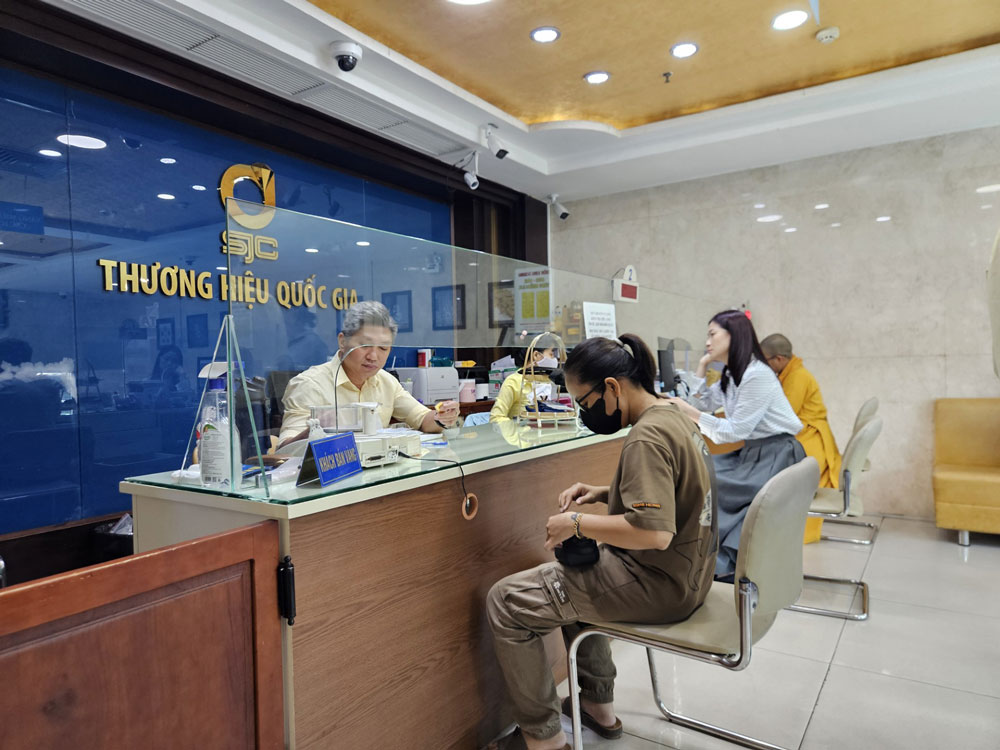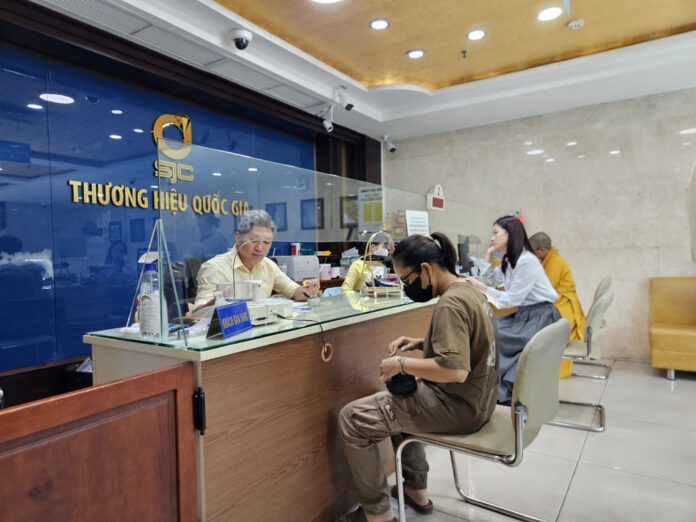After more than a decade of implementing a monopoly policy on gold bar production, the Vietnamese gold market is at an important turning point. In a notable directive, General Secretary To Lam has recently called for an end to the state monopoly on gold bar branding – a move that experts believe paves the way for a healthier, more transparent, and competitive gold market.
Towards Increased Competition and Transparency
During a working session with the Central Policy and Strategy Committee, the General Secretary emphasized the need for the state to continue regulating gold bar production but not necessarily maintain a monopoly. Instead, licenses could be granted to multiple qualified enterprises (DNs) to engage in production, thus creating a competitive environment, diversifying supply sources, and contributing to market stability.
This directive is expected to address the long-standing issue of gold price discrepancies between Vietnam and the global market. There were times when the SJC gold bar price was higher than the international converted price by up to 15-18 million VND per tael, causing significant losses to people buying gold for investment purposes. The root cause lies in the monopoly model, where the Saigon Jewelry Company (SJC), the sole state-owned enterprise authorized to produce gold bars under Decree 24/2012, could not meet the market demand from 2014 onwards, while the State Bank also halted the import of gold materials for an extended period.
This led to a scarcity of gold supply, particularly SJC gold bars. Even when the market experienced a surge in demand, such as in early 2024, the State Bank’s injection of 14 tons of gold into the market through commercial banks and SJC was not sufficient. This indicates that a tightly controlled, monopolistic market is susceptible to supply-demand imbalances, which is inconsistent with the requirements of a modern market economy.
Mr. Huynh Trung Khanh, Senior Advisor to the World Gold Council in Vietnam, stated that ending the monopoly and allowing capable enterprises to produce gold bars is just one part of the necessary solutions. Equally important is the licensing of gold material imports to sustainably expand the supply. “Without gold materials, even with production permissions, it would only be a formality,” he said.

Many people expect the price gap between SJC gold bars and world gold prices to narrow. Photo: LAM GIANG
Similarly, Dr. Le Xuan Nghia, former Vice Chairman of the National Financial Supervisory Commission, affirmed that the gold market is in an “abnormal” state, with almost no supply and persistently high demand, driving gold bar prices to unreasonable levels. According to him, opening up gold material imports and breaking SJC’s monopoly could bring the domestic and international gold price gap to a reasonable range of 1-2 million VND per tael, or about 2%, mainly due to taxes and fees.
Beyond ensuring supply, a healthy market also requires a modern and transparent trading system. Experts also hope that the State Bank will soon amend Decree 24 towards more radical reforms, rather than merely patching up immediate loopholes. A recent meeting of the Government Standing Committee also agreed on the need to amend Decree 24 through an expedited process to promptly provide a legal framework that aligns with reality and market development requirements.
From the perspective of a business directly involved in the gold market, Ms. Han Thi Binh, owner of Kim Phat I Private Gold Business (Ho Chi Minh City), shared that the demand for gold bar investment and accumulation, as well as gold jewelry, is currently very high among the people. Therefore, the state needs to open up the market and create favorable conditions for people to buy and sell gold more freely and conveniently.
Specifically, she proposed that the state should soon allow enterprises to import and export gold to ensure a stable supply of raw materials for gold bar and jewelry production, meeting domestic consumption demands and seizing export opportunities when market conditions are favorable. If enterprises are permitted to export gold, they will earn profits in foreign currency, contributing significantly to the country’s economy.
Establishing a Gold Exchange, Collecting Taxes, and Increasing Imports
According to experts, opening up the gold market does not mean lax management. On the contrary, it demands tighter control and systematization, especially through taxation and a transparent exchange mechanism. Economist Dr. Dinh The Hien emphasized the need to establish a clear taxation mechanism for gold trading. This would not only serve as a market regulation tool but also contribute to capital flow transparency.
“Currently, domestic gold prices are significantly higher than international prices, but the state does not benefit, while a substantial amount of foreign currency is being withdrawn. By imposing an import tax of 2-3 million VND per tael, the state can not only generate revenue but also help regulate the irrational gold hoarding mentality,” said Mr. Hien.
Along with the tax policy, many experts suggested that Vietnam should establish a national gold exchange connected to international exchanges, thereby promoting gold investment through accounts – a popular form in many developed countries.
Ms. Binh proposed: “There is a need to establish a gold exchange connected to international gold exchanges to meet the demand for non-physical gold investment. This would not only reduce the pressure on gold bar and gold ring purchases but also curb gold smuggling and stem the outflow of foreign currency. At the same time, gold shops nationwide should be allowed to buy and sell gold bars to facilitate people’s transactions.”
Mr. Tran Huu Dang, General Director of AJC Gold and Jewelry Joint Stock Company (Hanoi), expressed his hope that the State Bank would soon amend Decree 24 on gold trading activities in line with the directions of higher authorities.
He also suggested that the State Bank select a number of capable enterprises to undertake gold import and export and gold bar production. According to him, this would promote healthy competition and help narrow the price gap between domestic and international gold prices. As a result, people could make flexible decisions on buying or selling, helping to balance supply and demand and prevent gold price surges.
“The State Bank should establish a gold exchange and connect it to international gold exchanges, enabling investors to trade gold through accounts. Buyers would transact in USD, and upon selling, they would earn foreign currency, thus contributing to the USD supply-demand balance in the market,” said Mr. Dang.
No Concerns About Foreign Currency Shortage
Vietnam has ample foreign currency reserves to import gold materials. According to Mr. Shaokai Fan, Regional Director for Asia Pacific at the World Gold Council, in 2024, Vietnam earned up to $65 billion from trade surplus, foreign investment, and remittances. Meanwhile, the estimated demand for gold material imports is only about 20 tons, valued at $1.7 billion, which is well within the country’s payment capacity.
An Open Letter from Billionaire Tran Ba Duong: THACO’s Proposal to Invest in the High-Speed North-South Railway Project Valued at US$61.35 Billion
Chairman of THACO’s Board of Directors, Tran Ba Duong, has reached out to shareholders, partners, and employees regarding the company’s proposal to invest in the North-South High-Speed Rail Project. This move showcases THACO’s sense of responsibility and determination to contribute to Vietnam’s key national infrastructure projects.
Uncovering a $15 Million Fake Invoice Scam: A Skillful Operation Brought to Light
This is a large-scale illegal invoice trading ring, involving multiple businesses in the field of labor supply. The network is sophisticated and far-reaching, with a complex web of connections between companies. The scheme involves the fraudulent trading of invoices, with a significant impact on the economy and the potential for widespread fraud.
Is Your Business Ripe for the Picking?
In the global value chain, Vietnam’s participation has largely been confined to low-value processes such as manufacturing and assembly, which offer slim profits, little bargaining power, and easy replaceability. To break free from this mold, businesses need to embrace not just new machinery but also a novel mindset.





















